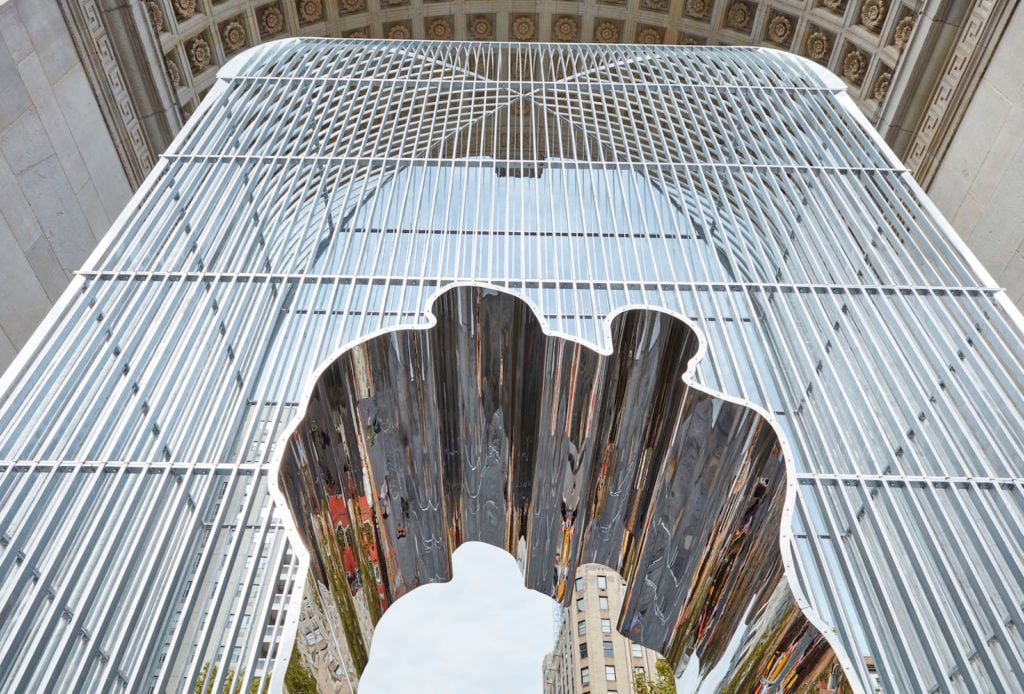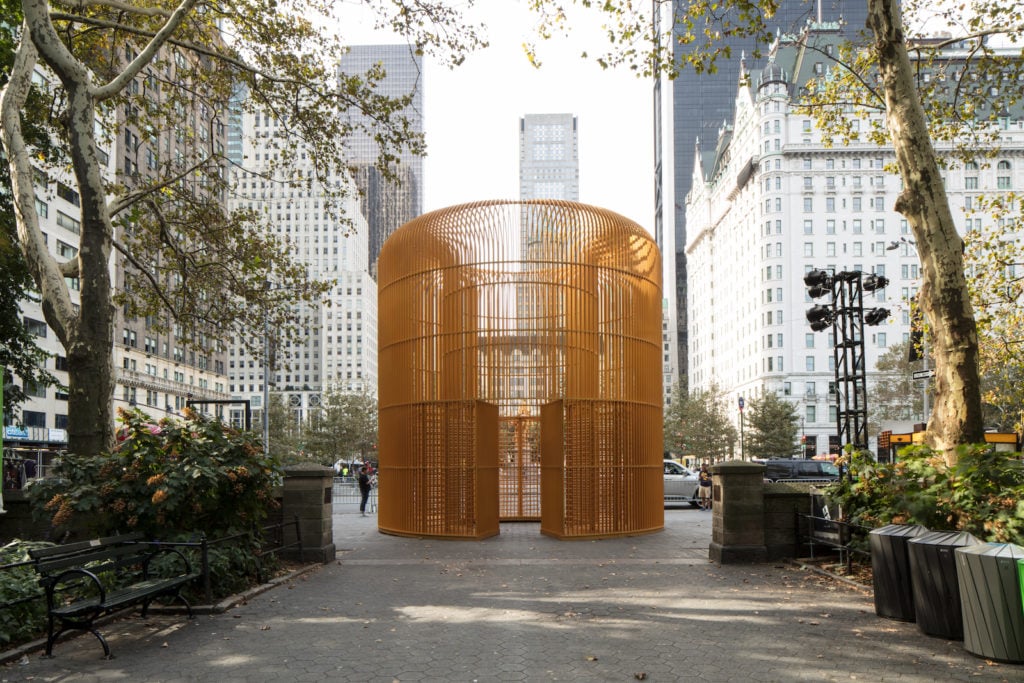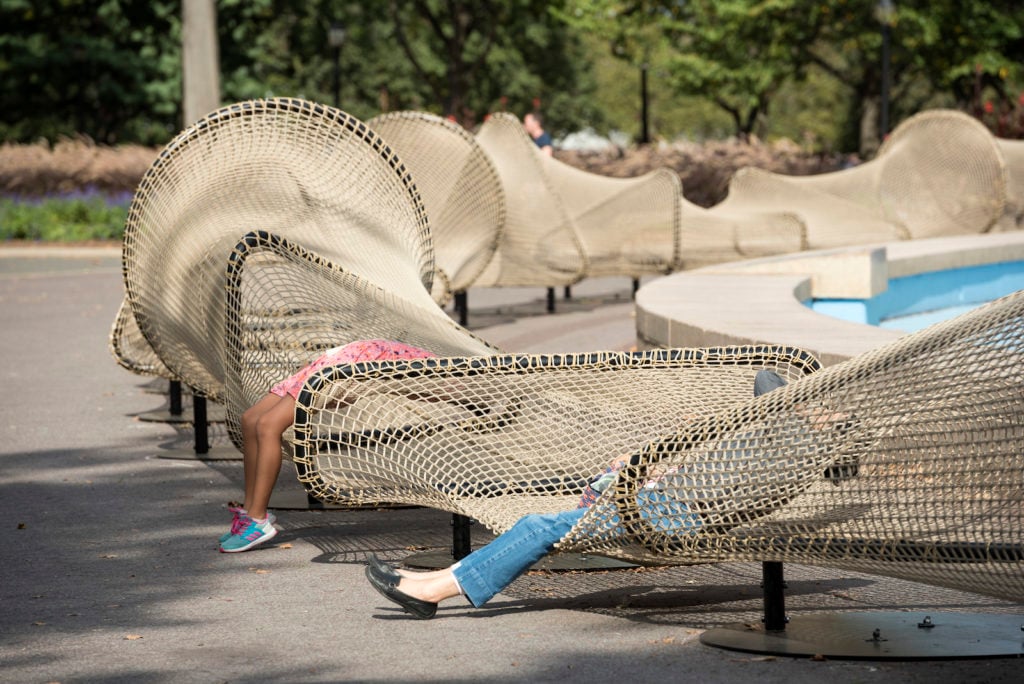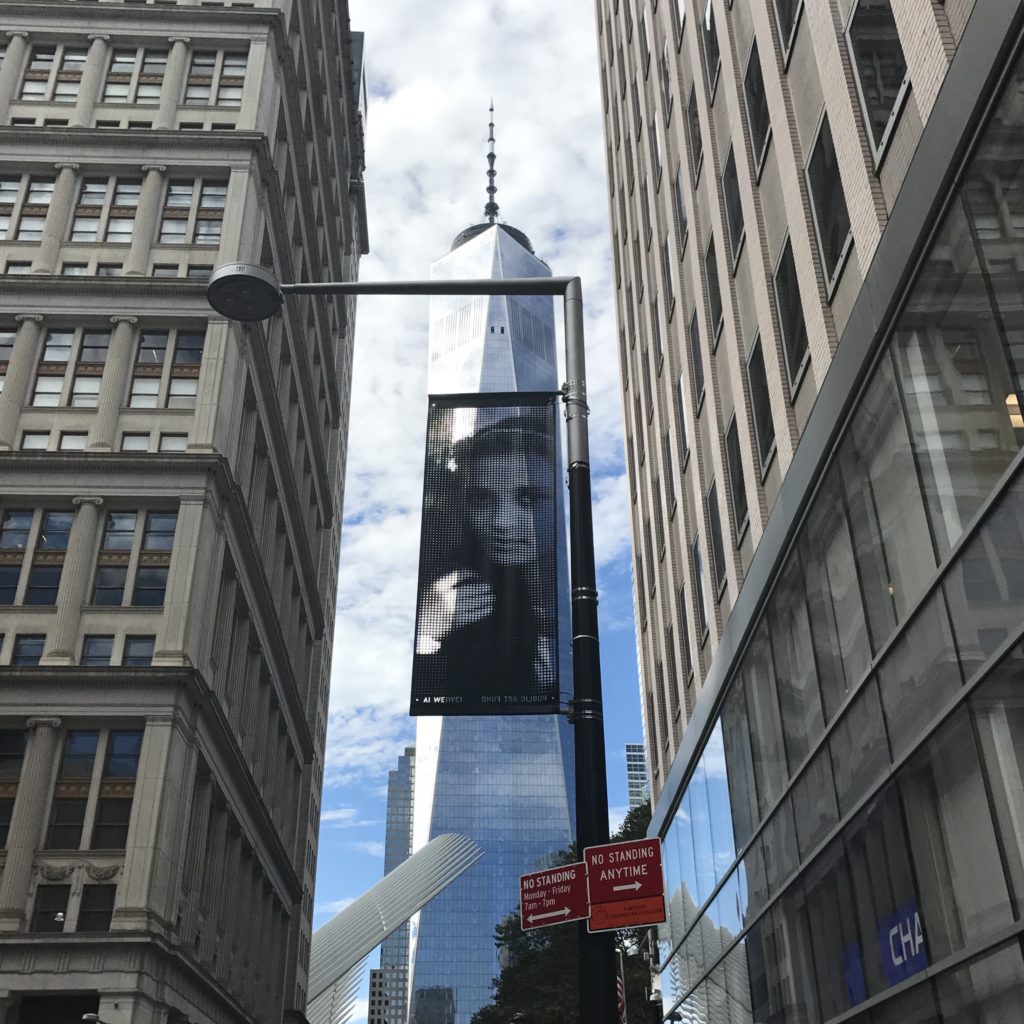On View
With an Enormous Art Installation in New York, Ai Weiwei Aims to Bring Home the Horrors of the Refugee Crisis
The famed Chinese artist's project spans some 300 sites citywide.

The famed Chinese artist's project spans some 300 sites citywide.

Brian Boucher

“Something there is that doesn’t love a wall,” wrote Robert Frost in his 1914 poem “Mending Wall,” in which the narrator’s neighbor insists on a barrier between their two properties. He offers the maxim, “Good fences make good neighbors.” The narrator responds by planting a question: “Why do they make good neighbors?”
Against the backdrop of an unprecedented refugee crisis and global waves of isolationist sentiment, Chinese artist and activist Ai Weiwei, like Frost’s narrator, asks that same question, advocating for connection in a massive project taking place throughout New York City and named after the neighbor’s proverb. Opening Thursday, “Good Fences Make Good Neighbors” is organized by New York nonprofit Public Art Fund, which celebrates its 40th anniversary this year. I joined Public Art Fund staffers and other journalists on a bus tour on Tuesday that visited some of the 300 sites the project occupies citywide.

Ai Weiwei, Gilded Cage (2017). Courtesy Public Art Fund.
The pieces of the project range from giant sculptures on the themes of barriers, fences, and boundaries—at sites like Manhattan’s Washington Square Park and the Unisphere, in Flushing Meadows Corona Park, in outer Queens—to more subtle photo- and text-based works that occupy some 200 lampposts and bus shelters in all five boroughs. The former include Gilded Cage (2017), sited at the southeast corner of Central Park, which takes the form of a gargantuan birdcage with an open top, and Arch (2017), which fills the space under the Washington Square Arch, in the eponymous park.
The lamppost pieces, meanwhile, take the form of portraits of refugees and immigrants, from today and from America’s past—the artist’s attempt to humanize the statistics. The plight of refugees has been one of Ai’s principal concerns in recent years. He has toured more than 40 refugee camps in two dozen countries while shooting a documentary, Human Flow; some of the portraits were shot during these visits.
Ai’s portraits aren’t all images of needy refugee children. One is the famed anarchist Emma Goldman’s mug shot, taken when she was arrested on suspicion of a link to the assassination of President William McKinley. (She was acquitted, though she did, separately, plot to assassinate robber baron Henry Clay Frick.) The bus shelter posters, meanwhile, bear photographs of border fences and walls along with informational text. We visited one, on 110th Street, that cites the Migration Policy Institute, which points out that in 1989, when the Berlin Wall fell, 15 countries around the world had border fences and walls. That number had grown to 70 by 2016.
The project’s opening follows by just a few days President Donald Trump’s latest bid to secure funding for a wall along the US’s southern border. The public art piece also comes amid a rocky debate over public statuary, namely monuments to the Confederacy, that has touched on what sorts of people should be commemorated on public grounds. Ai’s project aims to use public spaces to give voice to the voiceless. That dispute hasn’t left New York untouched; Mayor Bill de Blasio has appointed a commission to study public monuments throughout the city to identify “symbols of hate.”
(Ai’s project has caused its own minor controversy. Some locals tried to stop the artist from displacing a giant Christmas tree that typically stands near the archway in Washington Square Park during the holiday season, moving it to another spot in the park for this year. Add the artist to those waging the so-called War on Christmas.)
The artist and his family know plenty about the borders and walls, freedom and restriction of movement that are the project’s themes. Ai’s father, a celebrated poet, was punished during the Cultural Revolution with exile to menial labor in a Chinese village; Ai’s condemnations of the Chinese government won him a beating and temporary imprisonment from the authorities.
Some of the specific sites of his interventions in New York City’s landscape have even more personal associations. For example, on East 7th Street, he’s inserted a small, vertical strip of chain-link fencing into the space between two apartment buildings. He rented a basement apartment in one of them when he lived here as a student in the 1980s. As Public Art Fund director Nicholas Baume pointed out during the bus tour, the sculpture builds on structures that were already in place, a metaphor for the way that politicians aim to divide people along lines already drawn by structures of racism and xenophobia.

Ai Weiwei, Circle Fence (2017). Photo Timothy Schenck, courtesy Public Art Fund.
New York has a reputation as a progressive haven, but Public Art Fund’s associate curator, Daniel S. Palmer, told me that some observers of the project have taken up a pro-border position, recalling the neighbor in the Frost poem. (“I came here legally. Why can’t they do the same?”) And it’s not only policy that has come up for discussion with New Yorkers, but also aesthetics. Palmer said that one observer, studying Circle Fence, a ring of mesh netting that hugs the ground and surrounds the Unisphere, asked, “So, is that what you’re going to hang the paintings on?” Other, savvier onlookers have drawn comparisons to Christo and Jeanne-Claude’s The Gates (1979–2005), another sprawling public project whose theme was movement and which was created by immigrants.
The bus tour concluded at Washington Square Park, where Arch, a 40-foot-tall, cagelike structure with a passageway leading through it, stands below the Washington Square Arch, which was erected on the centennial of the inauguration of George Washington. The passageway contains a nod to Marcel Duchamp, a figure of more modest fame but who is one of Ai’s heroes. It takes the shape of two human figures whose silhouettes are joined, and echoes the entryway that Duchamp designed for André Breton’s Gradiva Gallery, in 1937. (Duchamp also frequently played chess in Washington Square Park after he supposedly quit making art.) A tour guide wearing a microphone was overheard to say she originally mistook the shape for something much more lowbrow—the silhouette of Mickey Mouse.

Ai Weiwei, Banner Portrait (2017). Photo Brian Boucher.
After a quick subway ride, as I walked back toward my office along Ann Street in Lower Manhattan, I looked up at the World Trade Center’s tower to find the face of a refugee looking down at me from a lamppost banner. The juxtaposition neatly ties together the terrorist attack that launched the world’s latest wave of isolationism and the abject faces of one of those left out in the cold.
“Good Fences Make Good Neighbors” is on view at various locations throughout New York City, October 12, 2017–February 11, 2018. A map of all the locations goes live on the Public Art Fund’s website on October 12.